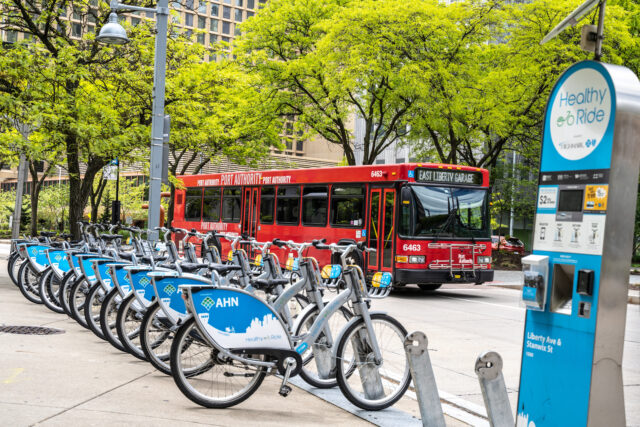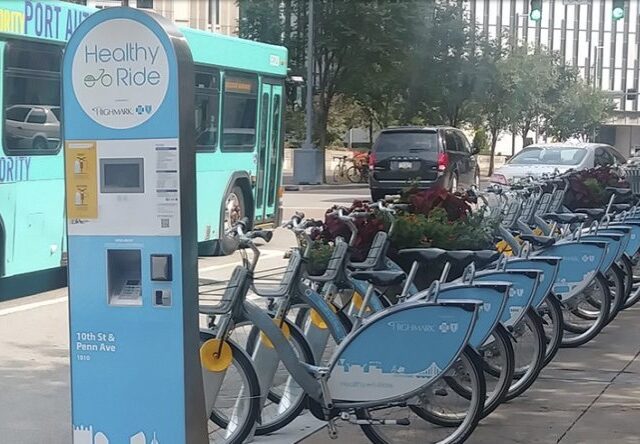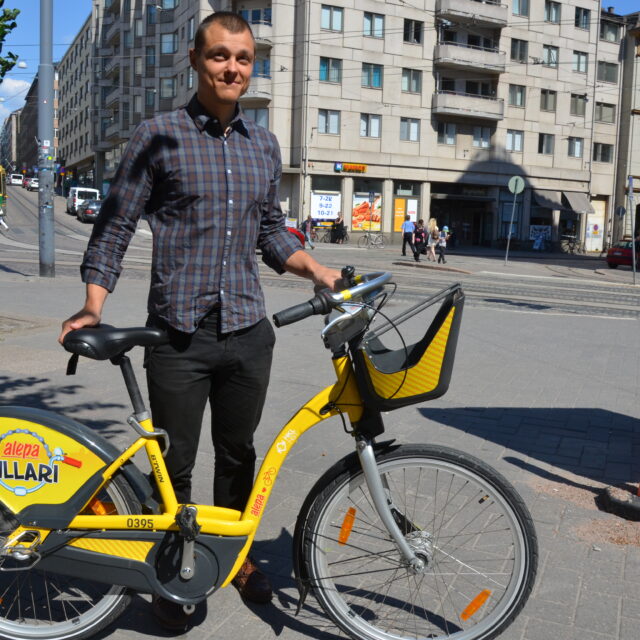Rethinking Transit on Transit Equity Day
by Kiran Herbert, Communications Manager
February 4, 2022
It’s time we normalize the fact that shared micromobility needs to be a part of every transit system — and how, when done right, it’s a win for equity.

Pittsburgh, Pennsylvania, USA- May 12, 2021: Healthy Ride bike share station with red public bus passing in the background.
For the last five years, a network of labor unions, community organizations, and environmental groups have declared February 4 Rosa Parks Transit Equity Day, in honor of the civil rights icon’s birthday. Today is all about celebrating and promoting public transit as a civil right, an issue that’s as important now as ever.
Not only has the pandemic hit our transit systems, riders, and workers especially hard — leaving hundreds of frontline transit workers dead — transit services have also been cut, resulting in a loss of jobs or hours for many. All of this has had an inequitable effect on low-income and BIPOC communities, who rely on transit most and are already on the losing side of an inequitable, racist public transportation system.
Transit Equity Day is about honoring the fact that affordable, accessible, renewable, and equitable public transit is the right of all Americans, regardless of where they live. Often, however, when talking about transit, shared micromobility is left out of the conversation. That oversight is a huge mistake — when done right, bike share and scooter share can play an integral role in bringing mobility to more people and creating a more equitable transit system.
When Parks first refused to give up her bus seat, sparking the Montgomery bus boycott in 1955, shared micromobility was still more than half a century away from being ubiquitous. Today, most cities have some form of bike or scooter share, with more and more adopting systems every year. Still, there are few places where bike share is housed within a city’s larger transportation authority — Austin and Los Angeles come to mind — and even fewer examples where payment systems are integrated between different modes, or where operators are working in conjunction with transit to place stations, determine schedules, and balance fleets.
We believe that fully integrating bike share and transit is the future, and a key component to increasing access and helping traditionally underserved populations get to where they need to go. Every day there seems to be a new example of a city making moves in the right direction, from Prague, where free bike share is now a permanent part of the city’s public transportation system, to New York City, where scooter company Beyond is studying how micromobility can be safely integrated with public transit.
Since the last Transit Equity Day, we’ve covered a handful of cities going all-in on integration. By drawing attention to them again here, we hope to help change the conversation around what an equitable transit system looks like and how we might get there together.
👉🏽 Pittsburgh Is Reimagining Mobility
In the United States, the most extensive MaaS project to date is currently underway in Pittsburgh, Pennsylvania, where the Department of Mobility and Infrastructure (DOMI) is working to make shared mobility more convenient, accessible, and equitable by offering users multiple transportation options through the Transit app and at new Mobility Hubs. Dubbed Move PGH, the two-year pilot program is making it easy for folks to seamlessly move from public bus to bike to car share, helping make car ownership obsolete.
👉🏽 Detroit’s Plan for Integrating Bike Share and Transit
For the more than 25% of Detroit households that don’t have access to a personal vehicle, transit is essential. MoGo, Detroit’s bike share system, realized that if it truly wanted to break down barriers and promote equity, integrating bike share into transit was a must. One of our five Living Labs, MoGo designed its proposal to create an easily accessible two-way bridge between bus transit and bike share. Over the course of two years, the nonprofit will put the $200,000 it receives in BBSP funding to “Building the Bike to Bus Connection.”
👉🏽 Boston’s Vision for Equitable Bike Share
In the last six years, Boston has reimagined the role of its Bluebikes bike share, deliberately positioning it as an integral part of the city’s public transit network. When Boston embarked on an extensive multi-year transportation review process — engaging thousands of residents and visitors — bike share wasn’t an afterthought.
👉🏽 Las Vegas Fully Integrates Bike Share and Transit
In Las Vegas, the Regional Transportation Commission of Southern Nevada (RTC) manages both bike share and transit. In May, the City of Lights became the first to fully integrate both within the Transit app. Now, Las Vegas riders can purchase transit and bike share passes with a single Transit app account, seamlessly transitioning from a bus ride to unlocking a bike.
Want to learn more about how your system can better integrate with transit? Check out this two-pager from the Transportation Research and Education Center (TREC) at Portland State University.
There is currently lots of work underway to reimagine shared micromobility as an extension of our transit systems. Does your city or organization have a story you want to share? Email kiran@peopleforbikes.org.



